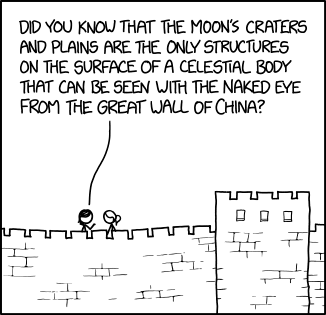The Moon and the Great Wall

And arguably sunspots, on rare occasions. But even if they count, it takes ideal conditions and you might hurt your eyes.

And arguably sunspots, on rare occasions. But even if they count, it takes ideal conditions and you might hurt your eyes.
This is a reference to the myth that the Great Wall of China is the only man-made object that can be seen from the Moon (or from space) with the naked eye. Sadly, it cannot. In fact, it's barely visible from the orbit of low satellites. Not only that, even if it was visible from space, it wouldn't be alone with that title. There are plenty of objects visible from space, the Chernobyl Nuclear Power Plant is able to be seen from space, so are the clusters of greenhouses in Almería Spain.
This comic mocks the myth by conflating it with another saying about the Moon, and how the Moon's craters and valleys are visible to the naked human eye. Indeed, the Moon is the only celestial body for which this is true, as all other bodies (with the potential exception of the Sun, see the title text) can only be seen as tiny points of light by the unaided human eye. There is nothing special about the Great Wall of China in this factoid, though; the Moon’s features can be seen equally well from practically any place on Earth with a view of the Moon.[citation needed]
The title text states that one is sometimes able to see large sunspots if any are present and conditions are ideal. However, looking directly at the sun with the naked eye risks extensive damage to the eye and should NEVER be done. It could, however, be possible to see them when the Sun is seen through a thin cloud cover or maybe at sunset/sunrise. (It's possible to see very large sunspots with solar eclipse glasses or other adequate protection, but that's not unaided human eye.)